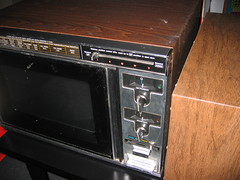This week's reading put me in mind of a problem I've witnessed in the interfaces around me. That is that, in a quest for increased functionality, device or software designers will make the interface more complex than it needs to be. My parents recently bought a new microwave. On my last trip home, I wanted to boil some water for tea. However, I was stopped by a microwave with something like 18 buttons and a little digital display.
The old microwave had three control surfaces. A latch on the door allowed the whole system to be turned on or off by the very intuitive action of either putting food in or taking it out, a dial allowed for selecting a cooking time, and another dial allowed for selecting the cooking intensity.
With the old microwave, my most basic interaction with the device (boiling water), was three steps:
1) Put the mug in and close the door, priming the system.
2) Check that the intensity is on "high," and if not set it to such.
3) Set the cooking time to three minutes by use of the dial.
If I was defrosting food, the procedure was:
1) Put the food in and close the door.
2) Check that the intensity is on "defrost," and if not set it to such.
3) Set the cooking time to the appropriate interval.
With only three control surfaces, and a largely stateless, analog machine, the procedure could never get longer than three steps.
However, with the new microwave, I still haven't figured out the intended procedure for boiling water. Presumably, there's a way to coax it into an "Enter time" mode, thus making use of the digit inputs, but the only way I've been able to do it is:
1) Put the food in and close the door.
2) Press the "clear" button until whatever is on the display is replaced with 00:00.
3) Press the "add minute" button until it's the desired cooking time rounded up to the minute.
4) Press "start."
5) Wait until the cooking time is up, if non-integer minutes are required.
6) Press the button to abort the cooking procedure.
The new machine has a number of features, like a "popcorn" button or a "defrost" feature. However, these functions were available in the old microwave, by use of the intensity dial. The new interface makes the rarest interaction as hard to perform as the most common one.
Photos of microwaves used under the Creative Commons license. Attributed to the persons to whose Flickr pages the images link.
The designers of the microwave either thought that the new interface would make the microwave easier to use or that buttons were more modern than dials. However, the old interface is much more intuitive. The same surfaces that are used as controls to set an input variable are the displays to show the status of the variable. The machine is stateless, so there's no different input modes to shuffle. When you approach the machine, you don't have to make sure what state it's in before you start inputing data.
This has caused me to become frustrated. I cannot say whether this is a general reaction to this microwave, as my parents seem fine with it, but my response was very negative.



